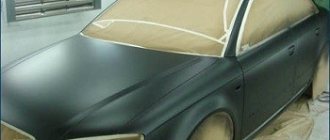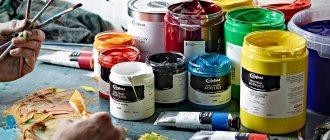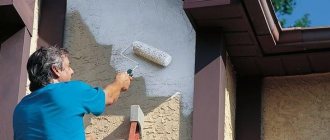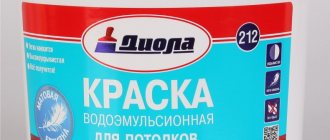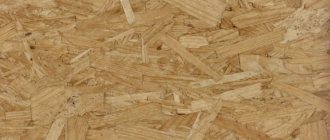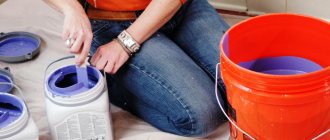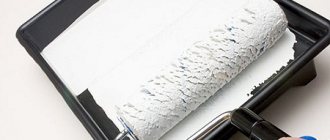Matte paint is considered a good solution for painting walls: with its help it is possible to hide small defects on the surface. Semi-matte is well suited for rooms where wet cleaning is often carried out. Before carrying out repairs, you need to familiarize yourself with the properties of the material used for painting.
Matte paint for painting walls.
Advantages of glossy paint
There are many advantages of a glossy surface. Benefits include:
- Moisture resistance. Glossy paint is an excellent option for the bathroom and kitchen;
- Easy to care for. The gloss withstands moisture and chemical exposure;
- Wear resistance. This characteristic allows you to frequently wash the ceiling surface.
These advantages allow you to create a beautiful, durable coating that is easy to care for. Also, with the help of glossy paint you can visually expand the space, which makes this type of coating indispensable in compact rooms. And spacious rooms with a glossy ceiling will look more impressive.
You can visually enlarge the room only if the glossy ceiling is in a light color scheme. But black, dark or bright colors visually reduce the size.
With the help of glossy paint you can visually expand the space, which makes this type of coating indispensable in compact rooms.
Flaws
Despite the undeniable advantages of this type of coating, it also has disadvantages. Thus, a pronounced gloss highlights all the defects and unevenness of the ceiling, so it is imperative to carefully prepare the surface before painting so that it is perfectly smooth. If such possibilities are not available, you can abandon the gloss in favor of a matte ceiling, which will hide all defects.
In addition, it should be taken into account that a glossy ceiling looks impressive only when the interior of the room matches the gloss. An interesting solution could be a combination of a glossy ceiling with the same walls.
The pronounced gloss highlights all the defects and unevenness of the ceiling, so it is imperative to carefully prepare the surface before painting so that it is perfectly smooth.
Silicone water emulsion
The paint is odorless and easy to work with. It has its own positive characteristics:
- Fits well on any surface, even stone and concrete;
- A perfectly flat surface is not needed; it can hide some unevenness;
- Can be used at any temperature;
- The paint layer retains water but allows air to pass through, so it can be called breathable;
- Fungi and mold do not form;
- Easy to clean;
- Not afraid of sunlight.
Minus the cost, expensive paint. But this is compensated by the service life (25 years). It is better not to apply it to a metal base, as the vapors activate the formation of rust.
Types of glossy paint
Based on the type of thinner, paints and varnishes are divided into 2 categories:
- Organo-dispersive, based on organic solvents;
- Water-soluble or water-emulsion mixtures. Typically used indoors;
- By type of film-forming component - resin.
Glossy water-soluble paints are not common, and latex-based compositions do not exist.
Water-soluble or water-based mixtures are usually used indoors.
Water-based glossy ceiling paint
Glossy water-based ceiling paint has the following advantages:
- No unpleasant odors;
- Minimal toxicity;
- Dries quickly;
- With the help of tints you can give paint a variety of shades;
- Easy to apply;
- Easily removed from tools.
The disadvantages of water emulsion are:
- Permissible painting temperature is not less than +5°C;
- It is impossible to carry out wet cleaning, otherwise the coating will be washed off.
With the help of tints you can give paint a variety of shades.
Acrylic gloss paint
This paint and varnish product is the most common. Painting compositions based on acrylic resins have the same advantages as water-based ones; they are not subject to fading and can paint any substrate. In addition, acrylic paints and varnishes are inexpensive. At the same time, they are even more durable and moisture-resistant than water-based paints.
Acrylic paints are more durable and moisture resistant than water-based paints.
Organosoluble gloss paint and enamel
As a rule, coloring compositions of this type are rarely used due to their toxicity, pungent odor and fire hazard. These paints include:
- Oil-based paints and varnishes based on drying oil;
- Aerosols and alkyd enamels based on alkyd resins;
- Polyurethane enamels based on polyurethane resins.
The only advantage of organo-dispersion paints is the wide range of gloss shades.
The only advantage of organo-dispersion paints is the wide range of gloss shades.
Characteristics
When choosing an acrylic coating, you should carefully read the technical characteristics and analyze important criteria.
| Manufacturer | You can not go wrong with the quality of the coating by choosing products from well-known brands. The products of the following companies deserve attention: Dulux, FARBITEX, LAKRA, DALI. |
| Application | On the label of each paint, the manufacturer indicates its purpose: façade, for walls/ceilings, baths and wet rooms, external and internal work. There are also universal options that can be used when performing any work. |
| Coverage type | The coating can be opaque or glaze. In the first case, the surface is densely painted even after one pass with a brush. In the second case, transparency is ensured. Glaze paints are used primarily for wood. |
| Washable or not | The material may include hydrophobic additives that allow the painted surface to be washed. Without them, cleansing is done using a dry method. |
| Processing material | When choosing paint, you need to consider the type of base. This determines how long the coating will last on a particular surface. The acrylic-based composition adheres well to drywall, stone, wood, brick, and plastered surfaces. |
| Heat resistance, frost resistance, moisture resistance | These indicators determine the purpose of the paint. It is important to consider them when choosing a façade covering. |
| Glossy or matte | After drying, the paint can form a glossy or matte surface. The variety is selected individually. The degree of gloss is determined as a percentage: - up to 5% - deeply matte, not giving shine; — 6-10% — matte, poorly reflecting light; — 11-29% – semi-matte, poorly reflecting light; — 30-59% — semi-gloss; — 60-89% — glossy with high shine; - from 90% - mirror shine. |
| Drying time | This type of coating has a high drying speed. The surface can be used after 1-3 hours. There are also quick-drying compositions that require only 20-30 minutes. |
| Color | The paint is available primarily in white. Using pigments you can achieve almost any shade. The components are mixed manually or on a special machine that selects the shade using a computer. Products are also available in a specific color. In production conditions, tinting is performed using a computer method. |
| Volume, l | Each manufacturer chooses its own packaging options. There are volumes ranging from 0.3 to 10 liters. |
| Weight, kg; | When choosing acrylic paint, it is important to correctly calculate the consumption. Some manufacturers indicate kilograms, others - liters. A 1 liter container contains 1.45-1.55 kg of coating. |
When choosing acrylic-based paint for different jobs, it is recommended to give preference to a universal composition.
How to choose ceiling paint
When deciding how to paint a glossy ceiling, it is important to remember that the decisive factor in this matter is the correct choice of paint and varnish. Thus, the first thing you should rely on is the coloring composition. But how to choose it correctly? When purchasing, you must consider the following nuances:
- The coloring mixture should be for indoor work. It is also worth choosing a specialized composition;
- No less important is the quality of the product, so the paint must comply with GOST.
Of course, many paints and varnishes can be tinted, but it is better to use a finished product in the desired color. You also need to take into account the amount of paint relative to the area of the base, taking into account such properties as hiding power. In general, the consumption of glossy paint and varnish for a ceiling surface measuring 10-12 m² will need 1 liter. paints.
Of course, many paints and varnishes can be tinted, but it is better to use a finished product in the desired color.
Preparing the base
Preparing the base for painting includes a certain set of works, the strict execution of which is designed to ensure the best quality of the surface. For example, the level of preparation that is suitable for wallpaper is completely unsuitable for painting. Moreover, even painting with paint with different effects requires a different approach in each specific case.
Palych R34FORUMHOUSE user
The surface quality at different stages has different tolerances.
- Internal plaster walls in residential premises - tolerance up to 2 mm clearance when checking with a 2-meter level. This is if lining or puttying is also planned.
- Internal plaster of walls under wallpaper - 1 mm clearance.
- The puttied surface under matte paint allows only small shadows in side light.
- The surface to be painted with semi-gloss and gloss paint does not allow any visible defects, as well as side shadows from light.
The use of clear standards in surface preparation in itself implies not only a high level of organization of the finishing process, but also facilitates control of the work. Visually, the quality of the surface is controlled using special flat lamps. With contrasting lighting, the flow of light is directed along the walls. If irregularities (bumps or depressions) are noticeable, it means that the surface requires additional putty.
Vladimir StarshovTechnical Specialist
The trend for smoothness and uniform surface finish dictates its requirements in relation to preparation:
- Perfect surface evenness
- The use of not only high-quality materials (plaster, putty, primer, fiberglass, etc.), but also appropriate technology for basic construction and finishing (quality of application, a certain set of sequential operations),
- Selecting the appropriate tool type (short pile roller or spray method).
From surface preparation, let's move on to an equally important and interesting issue: the choice of application method.
Semi-gloss ceiling paints
Among paints and varnishes there are intermediate semi-gloss paints; their gloss is moderate. Such paints are moisture resistant, durable and not subject to abrasion. However, in semi-gloss paints the composition of all these properties is less pronounced than in gloss paints. However, unlike glossy ceilings, they do not focus so much on the defects of the base. Therefore, you cannot always count on an unambiguously good result.
Such paints are moisture resistant, durable and not subject to abrasion.
Additional selection tips
- Always read the label on the can, especially the smaller print. This way you can find out about paint consumption per 1 sq. meter of surface, about its abrasion and moisture resistance.
- Buy only paint that is used for interior work, namely, for ceilings. This option drips much less and is more convenient. It is also possible to use products “for ceilings and walls”.
- Pay attention to compliance with GOST, not TU. In this case, you will protect yourself from purchasing a low-quality product.
- Do not try to tint white paints yourself. You can upset the proportions and end up with a completely different color than you planned. Let the seller do this.
- Buy water-dispersion paint only in stores that have warm warehouses. Once frozen, the water in its composition will disrupt the balance and structure of the product.
- Do not use oil-based paint on ceilings; this can ruin the ceilings, which suffer from a lack of air.
As you can see, each paint material has its own advantages. You just need to decide for yourself which characteristics are most important to you, depending on your wishes and financial capabilities.
Hand-painted ceiling with glossy paint
Painting the ceiling surface with a glossy paint and varnish is carried out in five stages:
- First, the old paint is completely removed from the surface, but if the base is smooth, without peeling coating, then this is not necessary.
- Leveling the base. All defects must be eliminated.
- Applying a primer solution suitable for this paint. If painting is done on an old coating, then no primer is required; sanding and degreasing the surface is sufficient.
- Using a small brush, spread the paint and varnish along the edges of the ceiling.
- Cover with a roller or spray gun over the entire area to be painted.
Using a small brush, spread the paint and varnish along the edges of the ceiling.
Preparatory work depending on the type of surface
Any painting must begin with preparing the base. Basic Rules:
- Household appliances, furniture and other things are removed from the room. Large items can be covered with film. The lamps are removable;
- Old paint is removed;
- The surface is primed.
Any painting must begin with preparing the base.
Drywall and gypsum fiber sheet (GKL and GVL)
Preparing the base from gypsum plasterboard and gypsum fiber board for coating:
- Using a spatula, use a spatula to treat the areas where the plasterboard is attached, so that the heads of the screws are covered.
- Dry cleaning.
- The corners are primed with acrylic solution.
- Prime the entire surface with a roller; after drying, apply the 2nd layer.
- After a day, the joints are covered with putty solution and sealed with reinforcing tape. Then the base is covered with a 2nd layer of putty on the seams. After drying, the seams are sanded with sandpaper.
- The drywall is completely puttied; after drying, the unevenness is eliminated with a spatula. The room is covered with film, a respirator is put on, and the ceiling is sanded with a construction trowel.
- Finishing putty. After drying, the ceiling is sanded again with a float.
- Dust is removed.
- The surface is primed for painting, and the ceiling dries within 24 hours.
The drywall is completely puttied; after drying, the unevenness is eliminated with a spatula.
Concrete ceilings
Preparatory work before painting the concrete base:
- The protrusions are removed with a hammer drill, and the cracks are widened using a knife.
- Irregularities are primed and sealed with mortar.
- The primer is applied, and after it dries, the procedure is repeated.
- Putty. After drying, the surface is sanded again with a float.
- Dust is removed.
- The surface is primed for painting, and the surface dries within 24 hours.
The surface is primed for painting, and the surface dries within 24 hours.
Wooden surface (plywood, chipboard, fiberboard)
Preparatory work for painting a wooden ceiling:
- The surface is cleaned with coarse grain.
- Treatment with antiseptic impregnation.
- Puttying cracks with a solution specially designed for wood.
- A new, flat ceiling is primed 2 times with drying oil. If there are defects, the wood must be puttied in several layers, with each layer carefully sanded.
- Next comes the primer for the paint.
Sheets of plywood, fibreboard and chipboard are prepared in the same way, only the primer solution is used specifically for chipboard, plywood and fibreboard.
If there are defects, the wood must be puttied in several layers.
Technology of applying glossy paint to the ceiling surface
When using glossy ceiling paint, it must be taken into account that all defects in the base will be clearly visible, so the work must be approached responsibly, following the instructions.
Work order:
- Good lighting is installed; if necessary, additional lamps can be used.
- The paint and varnish composition is prepared according to the manufacturer's instructions. More solvent is added to the first coating than to subsequent layers. Paint is poured into a special container in small portions.
- First, paint is applied in the corners and along the wall surface with a narrow brush.
- Then the entire surface is painted with a roller.
- The coloring composition is applied starting from the window with zigzag movements across the rays of light.
- Excess paint is removed with a clean roller.
- The next layer of paint is applied along the direction of sunlight.
The coloring composition is applied starting from the window with zigzag movements across the rays of light.
Features of painting the ceiling with different types of paints
The most popular is glossy water-based paint. However, many are interested in how to paint without leaving streaks. To do this, select a roller taking into account the following nuances:
- Handle size. The handle should be a telescopic handle or an extended one;
- Material. You need to use a fur roller;
- Density. A thick roller will be required;
- Seams. No rough seams;
- Pile. High-quality pile should not fall out.
The requirements for acrylic paint will be similar. For more even painting, you can use a spray gun.
For more even painting, you can use a spray gun.
Acrylic emulsion and wall painting
For painting walls, it can be used in any weather conditions, and it is possible to paint not only interior walls, but also the facades of houses.
To create an original author's drawing, not only simple acrylic paints are used, relief pastes are also used. For street art, paint is mixed with a special liquid. After completion of the work and complete drying, the applied paint does not peel off from moisture that has entered it and does not form cracks. The painting will last for many years without losing its beauty.
To completely protect the wall painting and preserve it for many years, you need to apply a transparent matte varnish, which is based on acrylic.
Possible difficulties when applying glossy ceiling paint and options for solving them
When working with glossy paints and varnishes, a number of difficulties may arise that can be solved as follows:
- Thickened paint. It will help to avoid this situation by refusing to buy products on the street, where the mixtures freeze; you should also look at the shelf life of the product;
- Formation of stripes. This defect can be eliminated by moving the roller to the side, then the composition will be distributed evenly;
- Surges. It is necessary to reduce the amount of paint on the roller and move it over the base longer.
The frozen paint must be strained, a solvent must be poured into it, stirred well, after which it can be used.
It is necessary to reduce the amount of paint on the roller and move it over the base longer.
Of course, a glossy ceiling looks luxurious and can add a special chic to the room. However, before you start painting, it is important to properly prepare the surface, choose a paint based on the base material and follow the painting rules.
Popular manufacturers
The variety of brands producing ceiling enamels in construction stores is great. The choice of paint depends on the personal preferences of the manufacturer, financial capabilities and the effect to be achieved. Among the popular ones, we highlight 8 manufacturers who have won the trust of users.
Tikkurila
The famous Finnish brand creates high quality finishes. The materials are used when working with problematic surfaces; they work well on putty, drywall and wood. The mixture contains substances with antibacterial properties that prevent the development of dangerous microflora and can be used in the bathroom and kitchen.
Finnish paints Source cmp24.com.ua

